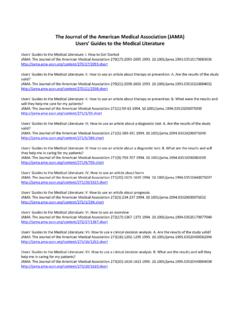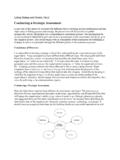Transcription of Interactive lecturing: strategies for increasing ...
1 In teractive lecturing: strategiesfo r increasingparticipation inlarge group presentationsYVONNE STEINERT & LINDA ofMedicine, McGill University, CanadaSUM MAR YInteractiv e lectu rin g involves an in cre ase d in ter -cha nge bet wee n teachers , stu den ts an d th e lecture co us eof interactiv e lectures ca n pr omot e active lea rni ng, hei ghte n atte n-tio n an d motivation , giv e fee dbac k to th e teacher an d th e st udent ,an d in crease satisfactio n fo r s article describe s a num be rof interactiv e tech niq ues tha t ca n be use d in larg e gro up presenta -tio ns as wel l as general strategie s tha t ca n pro mot e in teractivit ydur in g e you eve r give n or attended an interactiv e lecture?
2 Wha t wa s it tha t mad e it Interactive ?Wha t wer e you r im pres -sion s of thi s metho d of teaching?Whereas muc h ha s be en wr itte n about effective lecturingan d pres entation skill s in medical ed ucation (C ox & Ewan,1988 ; Laidlaw, 1988; Newble & Cannon, 199 4), littl e ha sbee n writte n about th e bene ts an d strategies of interactiv electurin g fo r medical teachers. The goal s of thi s article ar eto des crib e th e advantages an d indication s fo r interactiv electures , to discuss com mon fear s an d concerns about usin gthi s metho d of teaching, to outline a nu mbe r of interactiv etechnique s tha t ca n be incorporated int o medical teachingat al l levels, an d to highlight general guideline s fo r successfu linteractio n an d audience pa rticipation.
3 W hatis in teractive lecturin g?Interactiv e lecturin g ca n be interprete d in a nu mbe r ofdifferent ways. Fo r so me, interactiv e lecturin g involves atwo-way interacti on between th e pres ente r an d th epa rticipants . Fo r others, it refers to increase d discussio nam on g th e pa rticipants . Interacti on can als o re fe r to astudent s1involvemen t wit h thematerialor thecon tentof alecture; it doe s no t necessaril y mea n tha t th e audience ha sto do al l of th e talking. In al l cases, however, interactiv electurin g im plie s activ e involvemen t an d pa rticipation byth e audience so tha t students ar e no longer passive in th elea rnin g te ra ctiv e le ctu rin g als o im pli es a differ ent wa y ofapproaching th e teacher s role.
4 In giving thi s typ e of presenta-tion , the `instructor frequently becomes a `facilitator or`coach , an d mor e ofte n tha n not , ha s to modif y th e le ctur econtent to allo w fo r discussio n an d to tr y ne w techniques .Fo r th e purpose of thi s discussion , th e te rm `lecture wil lrefe r to an y larg e grou p presentation, at an y leve l of th eeducationa l system. It is im po rtan t to note , however, tha tth e nu mbe r of students in th e au dienc e doe s no t dictatewhether th e le ctur e ca n be Interactive .
5 So me ve ry sm al lgro ups can be no n-i nt era ctive , an d ce rtai n in ter activ etechnique s ca n be incorporated int o a clas s of ove r 20 0stu dents . Moreov er, al though la rge classe s are mostcom monl y considere d th e context fo r interactiv e lectures ,thes e technique s ca n als o be use d effectivel y wit h sm alle hygiv e anin te ractive lecture ?Lectures as a metho d of teaching an d transmittin g informa-tio n hav e co me under increasin g criticism (B ligh , 1972 ;Kim mel , 1992 ; Kroenke, 19 84) . One of th e majo r reasonsfo r thi s cr itiqu e is th e obse rvation tha t lectures ar e les seffective tha n othe r methods whe n instructiona l goal s involveth e applicatio n of informatio n or facts , the de velopmen t ofthinking skills, or th e modi cation of attitudes (F rederick ,1987 ; McK eachie, 19 94 ; Newble an d Cannon, 19 94).
6 Inaddition, students ar e freq uentl y see n as passive re cipientsof in formation, an d as a result, no t engaged in th e , whil e man y teachers accept th e notion tha tothe r teaching methods migh t be bett er tha n lectures fo rencoura gin g st udents to be more activ ely inv olv ed inlea rnin g, an d fo r pro motin g the applicatio n of knowledge ,fe w hav e th e ti me, resources or opportunity to us e th e sm al lgroup methods tha t pro mot e suc h involvemen t an d applica-tio n (Schwartz , 198 9) . Also , whe n do ne effectiv ely , th electurecantransmit ne w informatio n in an efficient way ,explain or clarify difficult notions, organize concepts an dthinking, challenge beliefs, mode l problem solving, an d foste renthusiasm an d a motivation fo r lea rnin g (G ag e & Berliner,1991 ; Fole y & Sm ilansky, 1980 ; Frederick , 19 86; Saroyan &Snell, 199 7).
7 The valu e of int eractive lecturing rest s on th e pre mis etha t activ e pa rticipation an d involvemen t is a prerequisit efo r lea rnin g beyond th e recall of facts , an d tha t studentsmus t be attentive an d motivated in orde r fo r lea rnin g tooccu r. In su mmar y, in te ractive le ctu ri ng pro mote s th efollowing characteristics of effective lea rning .Activ e involvemen tEdu cational research ha s shown tha t stud ent s who ar eactively involved in th e lea rnin g activity wil l lear n mor e tha nstudents wh o ar e passive recipient s of knowledge (B utler ,1992 ; Feden, 199 4; Kraft, 19 85 ; Murray, 19 91).
8 As we hav esai d earlier, interactiv e lecturing ca n pro mot e activ e involve-men t wit h th e material or th e content, wit h th e teacher, orwit h classmates /pee rs. Indeed, eve n students wh o do no tCorrespondenc e: Dr Yvonne Steinert, Faculty of Medicine, McGil l University ,365 5 Dru mmon d Street, Montreal, Quebec, Canada H3G 1Y6 . Tel : 51 4-398-2698 . Fax : 514-398-2231. Em ail : steinert@m ed. Teacher, Vol . 21 , No. 1, 199 90142-159X /99 /010037-0 6 $ 0 19 99 Carfax Publishing Lt d37tal k in clas s ar e ofte n sti mulated by questions or problem-solving exercises as the y thin k about wha t the y would answerin a pa rticular cre ase d attention an d motivationOthe r studies in education hav e de monstrated tha t increasedattention an d motivation enhance mem or y (G ag e & Berliner,199 1; Mannisonet al.)
9 , 199 4; Meyer s & Jones, 1993). Infact , so me authors hav e sai d tha t increased arousal an dmotivation ar etheessential in gredients fo r learning , an dofte n ar e mor e im po rtan t to retention tha n spa n studies hav e shown tha t students interestan d attention in th e traditiona l lect ure di minishes signi -cantly afte r 20 minutes (Frederick , 1986; Fole y & Sm ilansky,1980; Stuart & Rutherford, 1978). Energy shifts or changesof pac e ar e essentia l if stu den t att entio n is to re mai nfocused. By changing pac e an d incorporating a variety oftechnique s tha t arouse attention, interactiv e lectures ca nsti mulat e in te re st an d help to mai ntai n att enti on.
10 Byencouragin g application s to `rea l life situations or focusingon controver sia l issues, interactiv e le ctures als o motivatestudents to re ad an d lear n more .A `different kin d of lea rnin gIn addition to increasin g student involvement , attentionan d motivation, Interactive lecturing pro mote s a `higher level of thi nkin g (L ow man, 1984; Mic ha else net al., 1982;Ra msden , 1992).Thi s includes th e analysis an d synthesis ofmaterial, applicatio n to othe r situations an d evaluation ofth e material presented . In teractive lecturing ca n facilitat eproblem-solving an d decision- making, co mmunication skill san d `thinking on you r feet.








